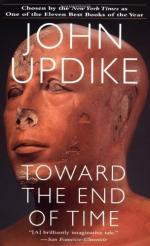|
This section contains 2,509 words (approx. 9 pages at 300 words per page) |

|
Few American writers so eloquently captured the rhythm and pace of life during the latter half of the twentieth century as did John Updike in his "Angstrom" novels (Rabbit, Run, 1960; Rabbit Redux, 1971; Rabbit Is Rich, 1981; Rabbit at Rest, 1990), his magnificent collections of stories about growing up precocious during the years of the Great Depression and the Second World War (Pigeon Feathers and Other Stories, 1962; Olinger Stories, 1964), and the beautiful but despairing stories about a modern marriage relentlessly crumbling (Too Far to Go, 1979). Updike's unerring ear for the details of our shared cultural experiences have created a verbal monument to half a century of existential angst, material acquisition, sexual revolution, environmental consciousness, and shifting transcendental beliefs.
Because of his gift for recording subtle cultural nuances, Updike is among the shrewdest, most lyrical observers of contemporary America. From the completely original vantage afforded by his revisiting Harry Angstrom...
|
This section contains 2,509 words (approx. 9 pages at 300 words per page) |

|




